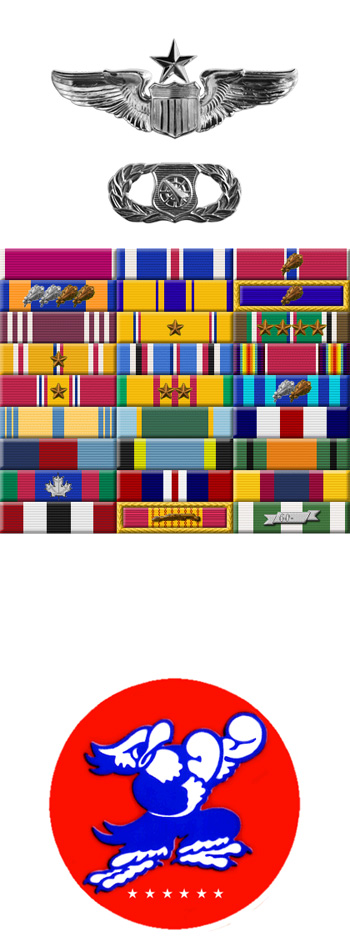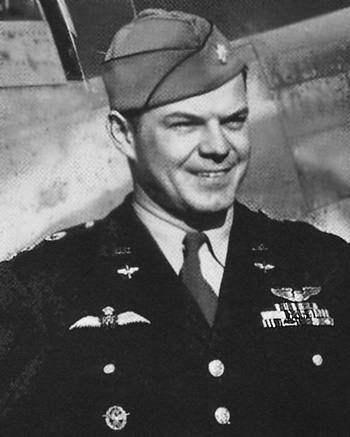
|
William R. Dunn |
 |
|||
| Rank, Service | ||||
Lieutenant Colonel O-5, U.S. Air Force |
||||
| Veteran of: | ||||
|
||||
| Tribute: | ||||
Bill Dunn was born on November 16, 1916, in Minneapolis, Minnesota. He enlisted in the U.S. Army on March 19, 1934, and served as an infantryman until receiving an honorable discharge on November 22, 1935. Dunn enlisted in the Royal Canadian Army on September 7, 1939, attaining the rank of Sergeant Major before joining the British Royal Air Force on December 13, 1940. After completing RAF Flying School at Tern Hill, England, on April 16, 1941, Pilot Officer Dunn was assigned to No. 71 Eagle Squadron from May to August 1941, during which time he became the first American fighter ace of World War II by destroying 5 German fighters in aerial combat plus a shared probable; all while flying British Hurricane and Spitfire fighters. After being wounded in action on August 27, 1941, Dunn was hospitalized for 3 months and then spent another 3 months in the U.S. on leave before serving as an instructor pilot in Canada until he transferred to the U.S. Army Air Forces on June 15, 1943. Lt Dunn served as a gunnery officer with the 53rd Fighter Group and then joined the 513th Fighter Squadron of the 406th Fighter-Bomber Group, flying the P-47 Thunderbolt, in October 1943, and deployed with the group to England in April 1944. He was credited with the destruction of his 6th and final enemy aircraft in aerial combat in June 1944, and later completed Command & General Staff College before transferring to China, where he served as commander of Luchien and Luchow Air Bases from May 1945 to 1947, participating in the Chinese Civil War on the side of the Nationalists. His next assignment was as an advisor to the Iranian Air Force from 1947 to 1949. Col Dunn resigned his commission on November 3, 1949, and rejoined the Air Force in an enlisted capacity on November 14, 1949, attaining the rank of Master Sergeant before receiving an appointment as an Air Force Warrant Officer on April 17, 1952. During this time, he served as an advisor to the Brazilian Air Force from 1950 to 1952. CWO Dunn served as a staff officer from 1952 to 1954, and then served as an Aircraft Controller, Intercepter Controller, Air Traffic Controller, and Wing Support Officer for the 33rd Air Division at Tinker AFB, Oklahoma, from May 1954 to February 1958. His next assignment was as a Weapons Controller with the 623rd Aircraft Control & Warning (AC&W) Squadron at Naha AB, Okinawa, from April 1958 to April 1960, and then with the 51st Fighter Interceptor Wing at Naha AB from April 1960 to July 1961. CWO Dunn next served as a staff officer with Headquarters 29th Air Division at Richards-Gebaur AFB, Missouri, from July 1961 to May 1963, followed by service as a Weapons Controller with the 848th AC&W Squadron at Wallace AS in the Philippines from May 1963 to May 1964. He served as a Weapons Officer on the staff of Headquarters Pacific Air Forces at Hickam AFB, Hawaii, from May 1964 to May 1967, and then deployed to Southeast Asia, where he served as a Weapons Force Plans Officer with the 6250th Support Squadron at Tan Son Nhut AB, South Vietnam, from May 1967 to June 1968. CWO Dunn's final assignment was as a Weapons Controller with Headquarters Air Defense Command at Ent AFB, Colorado, from June 1968 until his retirement from the Air Force on February 1, 1973. He was promoted to Chief Warrant Officer 4 (W-4) in 1963, but retired at his highest rank held of Lieutenant Colonel (O-5). Bill Dunn died on February 14, 1995, and was buried at the Fort Logan National Cemetery in Denver, Colorado. Although only officially credited with 6 air victories in WWII, Dunn claimed 8.5 in the air, plus 4 more unconfirmed, 3 probables, 4 damaged, and 12 more destroyed on the ground while strafing enemy airfields. |
||||
|
||||

